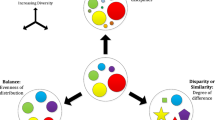Abstract
Significant correlations were found between the number of science journal editors from different countries, on the one hand, and the number of scientists, the number of science journals and the number of science papers produced by these countries on the other. We argue for using the extent of participation in the editorial board of international science journals as a new science indicator. The deviations from the regression lines between the new indicator and other publication indicators allow one to assess the “open” or “closed” character of the scientific life of a given country.
Similar content being viewed by others
References
D. de SOLLA PRICE,Little Science, Big Science, Columbia Univ. Press, 1963
F. NARIN,Evaluative Bibliometrics. The Use of Publication and Citation Analysis in the Evaluation of Scientific Activity, Computer Horisons Inc. Report No. 704 R, Washington D. C., 1976.
National Science Board,Science Indicators 1978, Washington D. C. Government Printing Office, 1979.
V. V. NALIMOV, Z. M. MULCHENKO,Naukometriya, Nauka, Moscow, 1969.
F. NARIN, M. P. CARPENTER: National Publication and Citation Comparisons,J. Am. Soc. Inf. Sci., 26 (1975) 80–93.
A. J. MEADOWS (Ed.),The Scientific Journal, London, Aslib, 1979.
J. D. FRAME, Measuring Scientific Activity in Lesser Developed Countries,Scientometrics, 2 (1978) 133–145.
M. D. GORDON: Disciplinary Differences, Editorial Practices and the Scattering of Rejection Rates for UK Research Journals,J. Res. Commun. Stud. 1 (1978) 139–156.
D. LINDSEY, T. LINDSEY, The Outlook of Journal Editors and Referens on the Normative Criteria of Scientific Craftmanship,Quality and Quantity, 12 (1978) 45–62.
J. COLE, S. COLE, Scientific Output and Recognition. A Study in the Operation of the Reward System in Science,Amer. Sociolog. Rev., 32 (1967) 377–390.
W. D. GARVEY,Communication: the Essence of Science, Pergamon, Oxford, 1979.
D. CRANE: The Gatekeepers of Science: Some Factors Affecting the Selection of Articles of Scientific Journals,Amer. Sociologist, 2 (1967) 195–201.
M. P. CARPENTER, F. NARIN: The Subject Composition of the World's Scientific Journals,Scientometrics, 2 (1980) 53–63.
Who is Publishing in Science (WIPIS), 1978, Philadelphia, Institute for Scientific Information, 1979.
J. D. FRAME, M. P. CARPENTER: International Research Collaboration,Soc. Stud. Sci., 9 (1979) 481–497.
H. INHABER: Where Scientists PublishSoc. Stud. Sci., 7 (1977) 388–394.
Author information
Authors and Affiliations
Rights and permissions
About this article
Cite this article
Zsindely, S., Schubert, A. & Braun, T. Editorial gatekeeping patterns in international science journals. A new science indicator. Scientometrics 4, 57–68 (1982). https://doi.org/10.1007/BF02098006
Received:
Revised:
Issue Date:
DOI: https://doi.org/10.1007/BF02098006



